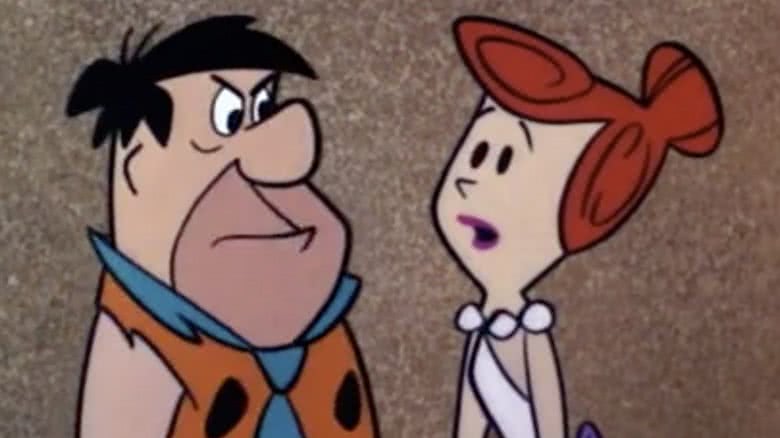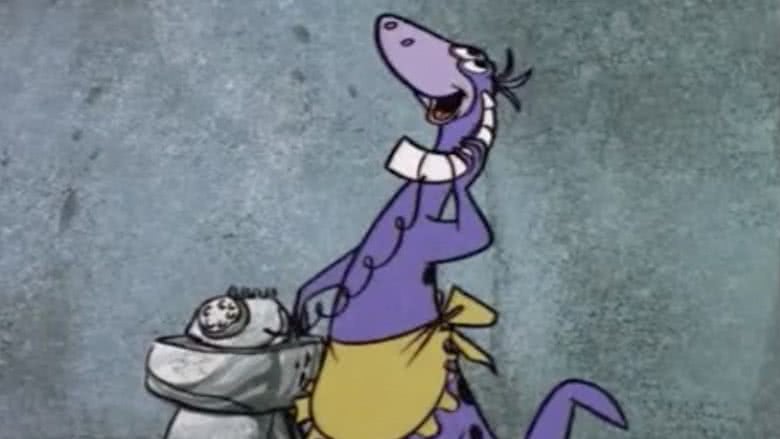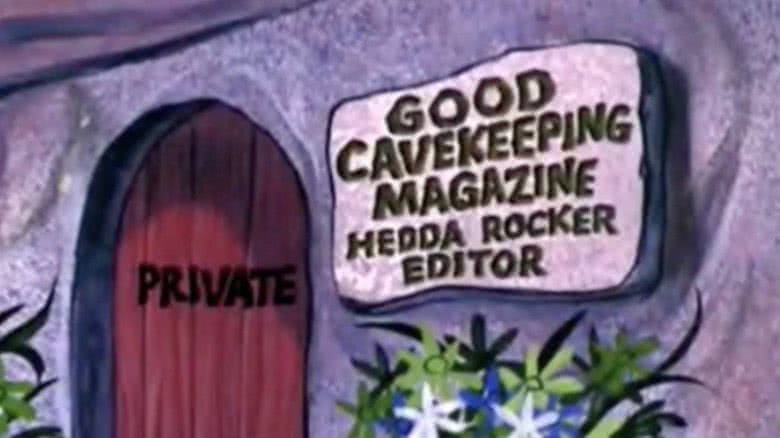The Untold Truth Of The Flintstones
One of the first-ever animated series to air on American primetime television, The Flintstones has made an indelible mark on pop culture since its debut way back in 1960. Combining wisecracking animals employed as appliances with the relatable sitcom plot-lines, The Flintstones never really left the collective consciousness after it left the air in 1966. Here's a piece right out of history about Fred, Wilma, Barney, Betty, Dino, and all the others from the town of Bedrock. (We yabba-dabba-do hope you enjoy.)
It almost had a different name
Rock and stone puns are the bread and butter of The Flintstones. The way everything on The Smurfs was "Smurf this" or "Smurf that," everything on The Flintstones reflected its Stone Age environs. Even the name "Flintstone" contains two rock puns. One would think that name, and hence the show's title, would have been a no-brainer from early on in the series' inception. But creators William Hanna and Joseph Barbera shot the pilot for the show under its original title: The Flagstones. That didn't quite work so they changed the name again—to The Gladstones. Finally, the show debuted in 1960 with its proper title.
It's pretty much a knockoff of The Honeymooners
While The Flintstones was original in many of its themes and approach, a lot of the show's DNA was pulled from The Honeymooners, a show of which Flintstones co-creator William Hanna was a big fan.
First a series of sketches on The Jackie Gleason Show in the 1950s and then its own standalone series, The Honeymooners depicted brash, know-it-all working stiff bus driver Ralph Kramden and his wife Alice who fought back against his nonsense. Next door were easy-going jokester Ed Norton and his wife, Trixie. Replace the grimy '50s New York tenements with some Stone Age tract houses, and you've pretty much got the Flintstones and the Rubbles. Both fictional guys even spent a lot of time at their respective lodges.
Honeymooners creator and star Jackie Gleason noticed, too. In the TV history book The American Family on Television, an associate of Gleason's said that the actor almost took up his lawyers' suggestion to sue the producers of The Flintstones—until he realized the mountain of negative publicity that would likely fall onto the man who pulled a beloved TV show off the air.
It had a different theme song at first
"Flintstones / meet the Flintstones / they're the modern Stone-Age family."
So begins the theme song to The Flintstones, one of the most famous in TV history. It dates from the era of television when shows actually had original theme songs instead of instrumentals or repurposed pop songs, and they were necessary to describe the premise of the show. "Meet the Flintstones" is so linked to the show that spawned it that it's kind of hard to believe that this wasn't the show's original theme song. It wasn't introduced until the third season—before that, a jaunty instrumental tune was used.
Fred and Barney once endorsed cigarettes
Today, TV companies buy blocks of advertising space during a show to sell their products. In the earlier days of TV, a series was proudly and boldly paid for by one or two "sponsors." The company then got their money's worth with the stars of the show breaking the action in the show to deliver a long commercial for the sponsor, sometimes in character.
Even though it was an animated show, The Flintstones was no different—and it was proudly sponsored by Winston cigarettes. Fred and Barney starred in special, Hanna-Barbera-produced cigarette ads that aired during The Flintstones in its original run. From a 2010s viewpoint, it's a little jarring to see both TV ads for cigarettes (the practice was banned in 1970), and to see kid-friendly cartoon characters doing the selling, not to mention smoking while they do so.
There was almost a detective-themed spinoff
There were many TV re-packagings, re-imaginings, and reboots of The Flintstones in the 1970s and 1980s, including The Pebbles and Bamm-Bamm Show (which was about the now-teenage Pebbles and Bamm-Bamm and their friends) and The Flintstone Kids (in which the Flintstones got the Muppet Babies treatment, depicting Fred, Wilma, Barney, Betty, and even Dino as children and/or puppies).
While the original series was still airing, there were discussions of a potential Flintstones spinoff. The first season episode "Love Letters on the Rocks" introduced an ace detective character named Perry Gunite, a parody of the actual 1960s TV series Peter Gunn. In 1985, a young animator was hired by William Hanna, and was allowed to pitch any project he wanted. The animator's idea: a standalone Perry Gunite series. That spinoff never got past the pitch and some concept art, but the animator, John Kricfalusi, went on to create The Ren & Stimpy Show.
Dino was a lot different at first
The Flintstone family's loveable pet dinosaur Dino was obviously supposed to be the Stone Age equivalent of a dog, what with his loyalty, tongue hanging out of his mouth, and affinity for attacking Fred with affection when he got home from work. He also barked, like a dog. But not always.
The first episode in which Dino prominently appeared was about Fred and Barney trying to hunt a "snorkasaurus." Instead, the crafty dinosaur winds up coming home with Fred, and Wilma puts him to work as a housekeeper and phone answerer. Dino speaks, in full, regular English, in a clipped tone and with much wit and charm.
The history of Flintstones Vitamins
Even though The Flintstones went off the air more than 50 years ago, its offshoot products are still widely consumed, particularly Flintstones Vitamins. Back in 1969, vitamin company Miles Laboratory (which later became a subsidiary of Bayer) scrapped a product called Charlie Chocks, the first-ever chewable vitamin for kids. They were fruit-flavored but generically-shaped, so Miles kept the recipe and then obtained the rights to shape the vitamins like characters from The Flintstones, including Fred, Barney, and Dino. Flintstones Vitamins remains among the bestselling children's vitamins on the market—a market it virtually created. By the way, Betty Rubble, a main character on The Flintstones wasn't added to Flintstones Vitamins until 1995. She took the spot in the vitamin lineup previously occupied by Fred Flintstone's car.
The rock puns were relentless and ridiculous
The Flintstones took place in the Stone Age, and the show never wanted you to forget that. Nearly every object, place, person, and parody of a famous person or institution had to have their 20th Century American name Flintstone-ified, which meant to awkwardly have a rock, stone, or prehistoric pun thrown in there somewhere. This pun-filled trope was even parodied on Saturday Night Live by John Goodman.
Among the least-rocking rock puns across Flintstones media: New Rock City (New York City), Texarock (Texas), Rockapulco (Acapulco), Hollyrock (Hollywood), Rock Vegas (Las Vegas), Gary Granite (Cary Grant), Rock Pile Hudstone (Rock Hudson) Jackie Kennerock (Jackie Kennedy), Ed Sullystone (Ed Sullivan), Ann-Margrock (Ann-Margret), Clark Gravel (Clark Gable), Arnold Palmrock (golfer Arnold Palmer), Sandy Stoneaxe (pitcher Sandy Koufax), Mickey Marble (Mickey Mantle), Jack Nickrock (Jack Nicklaus), The Indianrockolis 500 (The Indianapolis 500), and Prinstone University (Princeton).
Seth MacFarlane's reboot of the series fell through
In 2011, Fox announced that it had begun production on a brand-new The Flintstones series set to air in 2013. The show would be the responsibility of Family Guy, American Dad!, and The Cleveland creator—and lifelong Flintstones fan—Seth MacFarlane. This new Flintstones not only never made it to the air, it never even fully entered production. Despite Fox spending two years wrangling the rights for MacFarlane, executives reportedly read the first script MacFarlane's writers turned in and weren't pleased. That, coupled with MacFarlane's busy schedule making multiple television shows (as well as movies such as Ted), meant a new look at the modern Stone Age family fell apart.



